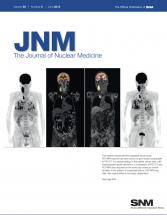Index by author
Cover image

The recently introduced first integrated whole-body PET/MRI scanner has been shown to give results comparable to PET/CT in a clinical setting. In the patient shown here, with metastasized thyroid carcinoma, a comparison of PET/CT and PET/MRI data acquired on the same day shows an overall similarity in the pattern of suspected lesions. PET/MRI may offer new opportunities in oncologic diagnostics.
See page 849



